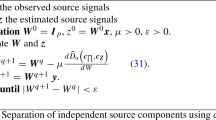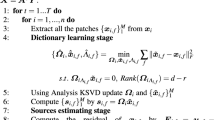Abstract
The independence priori is very often used in the conventional blind source separation (BSS). Naturally, independent component analysis (ICA) is also employed to perform BSS very often. However, ICA is difficult to use in some challenging cases, such as underdetermined BSS or blind separation of dependent sources. Recently, sparse component analysis (SCA) has attained much attention because it is theoretically available for underdetermined BSS and even for blind dependent source separation sometimes. However, SCA has not been developed very sufficiently. Up to now, there are only few existing algorithms and they are also not perfect as well in practice. For example, although Lewicki-Sejnowski’s natural gradient for SCA is superior to K-mean clustering, it is just an approximation without rigorously theoretical basis. To overcome these problems, a new natural gradient formula is proposed in this paper. This formula is derived directly from the cost function of SCA through matrix theory. Mathematically, it is more rigorous. In addition, a new and robust adaptive BSS algorithm is developed based on the new natural gradient. Simulations illustrate that this natural gradient formula is more robust and reliable than Lewicki-Sejnowski’s gradient.
Similar content being viewed by others
References
Cao X R, Liu R W. General approach to blind source separation. IEEE Trans Sig Proc, 1996, 44: 562–571
Comon P. Independent component analysis, a new concept? Sig Proc, 1992, 36(3): 287–314
Suzuki K, Kiryu T, Nakada T. Fast and precise independent component analysis for high field fMRI time series tailored using prior information on spatiotemporal structure. Human Brain Map, 2001, 15: 54–66
Lu W, Rajapakse J C. Constrained ICA. NIPS, 2000, 570–576
Lu W, Rajapakse JC. ICA with reference. Proc ICA2001, 2001, 120–125
Bell A J, Sejnowski T J. An information-maximization approach to blind source separation and blind deconvolution. Neural Comput, 1995, 7: 1129–1159
Xie S L, Zhang J L. Blind separation algorithm of minimal mutual information based on rotating transform. Acta Elect Sin (in Chinese), 2002, 30(5): 628–631
Hyvarinen A, Oja E. A fast fixed-point algorithm for independent component analysis. Neural Comput, 1997, 9(7): 1483–1492
Tan H Z, Chow T W S. Blind and total identification of ARMA models in higher order cumulants domain. IEEE Trans Indust Elect, 1999, 46(6): 1233–1240
Tan H Z, Chow T W S. Blind identification of quadratic nonlinear models using neural networks with higher order cumulants. IEEE Trans Indust Elect, 2000, 47(3): 687–696
Tan H Z, Aboulnasr T. TOM-based blind identification of nonlinear Volterra systems. IEEE Trans Instr Meas, 2006, 55(1): 300–310
Hyvarinen A. Blind source separation by nonstationarity of variance: a cumulant-based approach. IEEE Trans Neural Network, 2001, 12(6): 1471–1474
Matsuoka K, Ohya M, Kawamoto M. A neural net for blind separation of nonstationary signals. Neural Networks, 1995, 8(3): 411–419
Zhang J L, He Z S, Xie S L. Geometric blind separation algorithm for many source signals. Chinese J Comput (in Chinese), 2005, 28(9): 1575–1581
Li Y Q, Wang J. Blind extraction of singularly mixed source signals. IEEE Trans Sign Proc, 2000, 11: 1413–1422
Li Y Q, Wang J. Sequential blind extraction of instantaneously mixed sources. IEEE Trans Sig Proc, 2002, 50(5): 997–1006
Zibulevsky M, Pearlmutter B A. Blind source separation by sparse decomposition in a signal dictionary. Neural Comput, 2001, 13(4): 863–882
Belouchrani A, Cardoso J F. Maximum likelihood source separation for discrete sources. Proc EUSIPCO, 1994, 768–771
Lee T W, Lewicki M S, Girolami M, et al. Blind source separation of more sources than mixtures using overcomplete representation. IEEE Sig Proc Lett, 1999, 6(4): 87–90
Lewicki M S, Sejnowski T J. Learning overcomplete representations. Neural Comput, 2000, 12: 337–365
Li Y Q, Cichocki A, Amari S. Analysis of sparse representation and blind source separation. Neural Comput, 2004, 16(6): 1193–1234
Bofill P, Zibulevsky M. Underdetermined source separation using sparse representations. Sig Proc, 2001, 81: 2353–2362
Lee T W, Lewicki M, Sejnowski T. ICA mixture models for unsupervised classification of nongaussian sources and automatic context switching in blind signal separation. IEEE Trans Patt Recogn Mach Intel, 2000, 22(10): 1–12
Zhang L Q, Amari S, Cichocki A. Natural gradient approach to blind separation of over-and undercomplete mixtures. In: Proc of ICA1999, Aussois, France, Jan. 1999. 455–460
Donoho D L, Elad M. Maximal sparsity representation via l 1 minimization. In: Proc National Academy Science, 2003, 100: 2197–2202
Takigawa I, Kudo M, Toyama J. Performance analysis of minimum l 1-norm solutions for underdetermined source separation. IEEE Trans Sig Proc, 2004, 52(3): 582–591
Parra L, Spence C. Convolutive blind separation of nonstationary sources. IEEE Trans Speech Audio Proc, 2000, 8: 320–327
Author information
Authors and Affiliations
Corresponding author
Additional information
Supported by the National Natural Science Foundation of China (Grant Nos. 60505005, 60674033, 60774094 and U0635001), the Natural Science Fund of Guangdong Province, China (Grant Nos. 05103553 and 05006508), the Postdoctoral Science Foundation for Innovation from South China University of Technology, and China Postdoctoral Science Foundation (Grant No. 20070410237)
Rights and permissions
About this article
Cite this article
Yang, Z., He, Z., Xie, S. et al. Adaptive blind separation of underdetermined mixtures based on sparse component analysis. Sci. China Ser. F-Inf. Sci. 51, 381–393 (2008). https://doi.org/10.1007/s11432-008-0030-4
Received:
Accepted:
Published:
Issue Date:
DOI: https://doi.org/10.1007/s11432-008-0030-4




